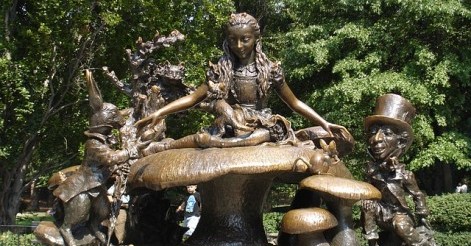
It’s not exactly science news, but this item on the role of fiction in engaging the scientific imagination really caught the eye of this science fiction fan. I’m familiar with Alice’s Adventures in Wonderland and Flatland, both of which encode interesting mathematics questions as narrative, but I had no idea scientific fairy tales were a whole genre. The one with the various chemical elements embodied as fairies sounds particularly fascinating. Knowing how much my daughter and her friends love fairies, perhaps it’s time for that one to make a comeback.
When science is so frequently pitched as pragmatic, empirical, and at odds with anything fanciful, it’s easy to think imagination has little place in science. Yet a key feature of scientific thinking is the ability to imagine what the world would be like if a particular model, or story about the world, is true. That’s not so different from what Lewis Carroll did, imagining what a world would be like if certain properties of numbers were physically manifest. So cultivating imagination with stories like these actually could provide a foundation for scientific exploration.
Which makes me wonder about the current state of science fiction. These Victorian stories have a sheen of the fanciful, but real-world science is in the subtext or baked into the world building. I’ve started to wonder if some of our modern stories get this backwards. On the surface, they demonstrate concern for making the science plausible, and whenever it isn’t you can be sure someone will call it out on Twitter. Yet sometimes what comes across in the subtext bears little resemblance to the world we inhabit — at least as I read it. For example, how many stories about robots and artificial intelligence ultimately have a message about the “heart” being the essence of humanity that machines can never duplicate, when in reality automatic emotional responses are much easier to explicitly program than the reasoning we associate with the mind?
What are your favorite stories that teach science indirectly? Have you encountered stories that seemed scientific at first until you started scratching at the surface?
Note: Part of Andy Walsh‘s exploration of Science on the Emerging Scholars Network Blog. As you have topics, articles, books, films, etc. which you desire for us to address/interact with (possibly even by writing a post of your own), please email us. Thank-you!
Andy has worn many hats in his life. He knows this is a dreadfully clichéd notion, but since it is also literally true he uses it anyway. Among his current metaphorical hats: husband of one wife, father of two teenagers, reader of science fiction and science fact, enthusiast of contemporary symphonic music, and chief science officer. Previous metaphorical hats include: comp bio postdoc, molecular biology grad student, InterVarsity chapter president (that one came with a literal hat), music store clerk, house painter, and mosquito trapper. Among his more unique literal hats: British bobby, captain’s hats (of varying levels of authenticity) of several specific vessels, a deerstalker from 221B Baker St, and a railroad engineer’s cap. His monthly Science in Review is drawn from his weekly Science Corner posts — Wednesdays, 8am (Eastern) on the Emerging Scholars Network Blog. His book Faith across the Multiverse is available from Hendrickson.

Leave a Reply